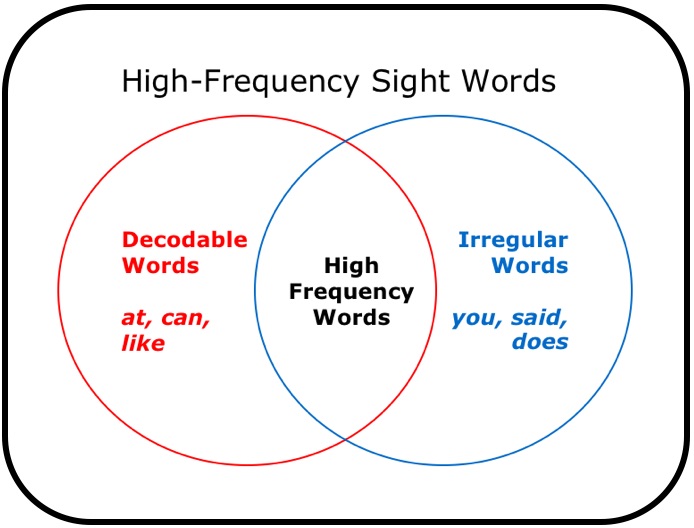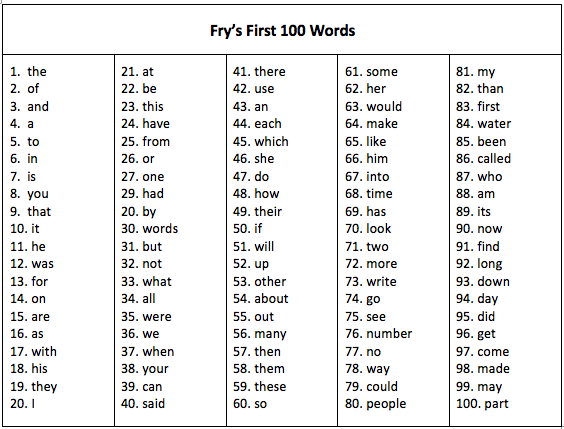High Frequency Sight Words

Educators sometimes confuse the following related terms: sight words, high frequency words, decodable words, irregular words. Sight words are words that are instantly recognized and identified without conscious effort. High frequency words are the words most commonly used in the English language. Because high frequency words are essential to learning how to read, teachers should begin to teach some high frequency words as sight words to children in primary grades at the same time children are being taught how to use phonics to decode words. Teachers introduce these words as soon as kindergarten if their students are ready.
Some high frequency words are decodable – they can be “sounded out” using regular phonics concepts (e.g., in, and, had, that, him, did, then, with, down, at, on, can, like). Some high frequency words are irregular – they are not phonetic and must be read as a unique word (e.g., the, was, from, have, of, there, want, you, said, does). When a teacher introduces a new high frequency word, it is helpful to point out to children if it is irregular or if it is decodable using the phonics concepts the children have learned.
At first, high frequency words are the words young students learn to read by sight (e.g., the, what) along with words that are meaningful to each child (e.g., family names, name of their town). Over time, many words that young students read by applying decoding skills eventually become sight words – that is, students learn to read them automatically by sight through the orthographic mapping process.
There is no definitive list of which high frequency words should be taught at which grade level or at which time of year in a grade level. Reading programs typically incorporate some instruction of high frequency words into daily lessons. Teachers can also select words to teach from word lists such as the Fry 100 List (the 100 most common words used in English, ranked in order of frequency, Fry, 1980). See the list at the end of this post.
Instructional Suggestions
- Follow a consistent procedure for teaching students to read and spell a high frequency word that is multisensory and includes multiple exposures. For example:
- Teach new high frequency words before students encounter them in text they are reading.
- Write the word on the board (or show it on a card) and spell it aloud pointing to each letter. Describe the parts of the word that are regularly spelled and the parts that are not.
- Students spell and trace the letter in the air (e.g., air writing) to support large muscle memory or on paper using two fingers to support fine muscle memory.
- Students cover the word and try to picture it in memory, then try to write it from memory.
- Students repeat steps 3 and 4 several times to develop automaticity to read and spell the word.
- Limit the number of words introduced at one time.
- Introduce visually similar irregular words, such as where and were or was and saw, in separate lessons to avoid confusion (Carreker, 1996).
- For irregular words, help students discover the parts of the word that do not represent their most common sounds. Circle or underline the irregular pattern (e.g., said, from) (Carreker, 1996).
- Spiral back and review words that have been previously taught.
Resources:
- The Really Great Reading Company has a free resource “Heart Word Magic” for helping students learn sight words, especially those that are not decodable (irregular). This resource is a growing collection of 2-minute videos that review information about a sight word such as said, from, and have. They can be used in a virtual teaching situation. Click here to access.
- Read the article “A New Model for Teaching High-Frequency Words” (Farrell, Hunter, Osenga) at the Reading Rockets website.
- The website SIGHTWORDS offers a collection of instructional resources.

References:
Carreker, S. (1999). Teaching spelling. In J.R. Birsch (Ed.), Multisensory teaching of basic language skills. Baltimore: Brookes.
Fry, E. (1980.) The new instant word list. The Reading Teacher, 34(3), 284-289

 Joan Sedita is the founder of Keys to Literacy and author of the Keys to Literacy professional development programs. She is an experienced educator, nationally recognized speaker and teacher trainer. She has worked for over 35 years in the literacy education field and has presented to thousands of teachers and related professionals at schools, colleges, clinics, and professional conferences.
Joan Sedita is the founder of Keys to Literacy and author of the Keys to Literacy professional development programs. She is an experienced educator, nationally recognized speaker and teacher trainer. She has worked for over 35 years in the literacy education field and has presented to thousands of teachers and related professionals at schools, colleges, clinics, and professional conferences.
hi ,joan thanks for the list,
had a doubt, what is difference between dolch sight words andfry sight words
Anyways i have taught dolch one to my son, Do i need to do this
They are very similar. The Dolch list is just 220 and does not includes nouns. The Fry is 1000 and includes all parts of speech. For young children, picking words from the beginning part of either list is fine since there is no “rule” about which high-frequency words should be taught first or the order. By the time most students are at the end of grade 3 with fluent, grade reading skills, it is not as necessary to teach all the words on these list because the student will get sufficient exposure just through wide reading that these words will be recognizable by “sight” after only a few exposures to the words.
Hello Joan
Thank you for such a descriptive information,this will really help me a lot in my teaching as a Para.
The list of Fry words was helpful
Thank you very much Joan! This is very helpful!
Hi Joan –
I came over to this post via your post on orthographic mapping, which I found to be very accessible and informative.
I’ve been studying the teaching methodology, and related research, of Structured Word Inquiry (SWI). I’m doing my best to make sense of the Science of Reading research + instructional implications alongside the methodology of SWI.
I can see that many of your suggestions in this post are consistent with the instructional ideas of SWI – especially the importance of explicit instruction and the idea of “writing out loud” or “air writing”.
One main difference that I am seeing is the idea of irregular spellings. SWI offers orthographic information to explain that the conventions that represent English spellings are so well ordered that they can be investigated through the scientific inquiry process. For example, is the base word with the affix fixed to it.
SWI focuses on increasing the lexical quality of words, by examining the meaning of words, looking at related words (morphologically + etymologically), examining the structure of words, and examining the phonology of words. SWI takes a linguistic approach to orthography, where morphology, etymology, and phonology are equal. The core idea in SWI is that the primary function of English spelling is to reflect meaning, and that there are reasons for the way that every word is spelled.
There is quite a lot more depth to the field of SWI, and the related research regarding this methodology. My question to you is if you have examined this methodology and / or looked at any of the related research on the implications of morphology in reading instruction.
If not – here is a great primary resource to consider.
http://files.realspellers.org/PetesFolder/resources/key_SWI_concepts_and_terms.pdf
I’d love to hear your thoughts on this topic, and would be very interested in discussing this further. I think that SOR and SWI are quite aligned in many ways. My main interest is in bettering my practice and learning more.
Thank you for all of these really great posts you have put together!
Pete Bowers and his colleagues have made some excellent contributions to our field with SWI. Especially for students beyond grade 2 when it is important to focus on morphemes in words to support both advanced decoding of multisyllable words and for a vocabulary strategy for figuring out the meaning of an unfamiliar word. Thanks for your comments and link to info on SWI!
This article has been extremely helpful! I have been teaching kindergarten for 25 years and have never read such a succinct and spot on description for teaching sight words/high frequency words.
Thank you!!!